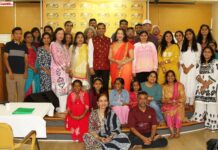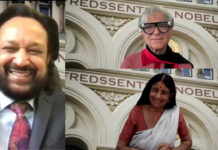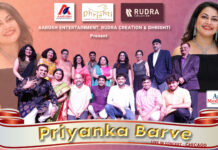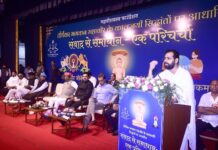
CHICAGO: Visually challenged students from Deepa Academy of Bangalore presented a potpourri of classical and folk dances under the banner “Empowerment of the Girl Child” on Saturday, October 5 at Sri Venkateswara Swami temple in Aurora, a south west Chicago suburb.
The free event was hosted by North America Telugu Society (NATS), Chicago Telugu Association (CTA), and the Balaji Temple, but voluntary donations were collected with all proceeds going to the school
The danseuses were six students Suma Rajanna, SJ Sowmya, Gulab Sha, K Rashmi, KR Pallavi and GV Lathamani, accompanied by their two dance teachers Shweta Venkatesh and Kavyashree Nagaraj. Founded in Bangalore in 2006, the Deepa Academy is a voluntary empowerment center for the blind who are otherwise quite talented, especially from rural Karnataka. It seeks working towards their education and rehabilitation, with the aim of making them self supporting and integrated into mainstream society.
R. Swaminathan, who is group head and coordinator, began and ended by thanking all the sponsors and facilitators of the event. He underlined the challenges of training the visually challenged in such a diverse variety of dance forms. The young danseuses were led around the unfamiliar stage to internalize its spatial dimensions. Strips had been laid across and through its center as aids in orientation.
Nevertheless, the individual and group coordination exhibited by the six students indicated that this artistic medium had enhanced their awareness of responsiveness towards their immediate changing environment and in their interactions with otherwise barely seen others. They were able to remain in formation while traversing the stage, rotate their arms to form a moving circle, slither, cross swords in battle, and even perform acrobatics.
They began with two Bharatanatyam items. Mallari set to raga Gambhira Nattai depicted the procession of the mobile icon of the deity around the temple-town to the accompaniment of drums, wind pipes, cymbals, and conch, with offerings of flowers.
Shatchakra enacted the raising of Kundalini from the base of the spinal column upwards through the six centers (chakra), each presided over by a specific mantra, element, and deity, until it blooms at the thousand-petalled lotus above the crown of the head to immerse the yogi in perpetual bliss.
Venkatesh and Nagaraj performed two duets in Kathak style. Ramdas’ Prabandh was a technical composition set to Teen Taal highlighting its various technical elements. Their subsequent two-part Tirwat mainly in raga Madhukauns was first set to different melodies then to different rhythms, ending in competition between pakhwaj and tabla, where they rivaled each other in displaying dexterous footwork with the ankle bells.
The six students continued with their first folk number, the Kolata stick dance from Andhra and Karnataka. In solos, in duets, in trios the revelers struck their sticks to create an audio trail that followed their geometric movements that seemed to produce an invisible fabric of dance.
The acrobatic Kamsali is derived from the performances improvised by wandering Veera Shaiva mendicants (jangama) as they awaited food at doorsteps in the Karnataka hamlet that is home to their deity. The brass plate and cup used to receive alms were rhythmically clashed to the accompaniment of songs that extolled the play of Lord Mahadeshwara.
After their Tirwat, Shweta and Kavyashree joined their students to pay homage to two ancient martial art forms of India and the warriors who had preserved them. Using the motifs of Thang-Tha and Kalari Payattu, the dance was also performed with swords and shields.
The student presentation concluded with Bhangra, the virile harvest dance from Punjab performed with martial movements but as an expression of joy, nowadays also by women.
Asian Media USA






